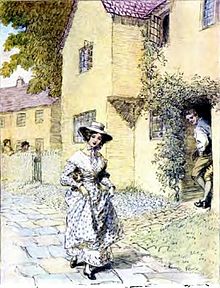Scenes of Clerical Life

Frontispiece of 1906 Macmillan edition of Scenes of Clerical Life drawn by Hugh Thomson
|
|
| Author | George Eliot |
|---|---|
| Illustrator | Hugh Thomson |
| Country | United Kingdom |
| Language | English |
| Genre | Short story compilation |
| Publisher | William Blackwood & Sons |
|
Publication date
|
1857 |
| Media type | Print (hardback & paperback) |
| Followed by | Adam Bede |
Scenes of Clerical Life is the title under which George Eliot's first published work of fiction, a collection of three short stories, was released in book form; it was the first of her works to be released under her famous pseudonym. The stories were first published in Blackwood's Magazine over the course of the year 1857, initially anonymously, before being released as a two-volume set by Blackwood and Sons in January 1858. The three stories are set during the last twenty years of the eighteenth century and the first half of the nineteenth century over a fifty year period. The stories take place in and around the fictional town of Milby in the English Midlands. Each of the Scenes concerns a different Anglican clergyman, but is not necessarily centred upon him. Eliot examines, among other things, the effects of religious reform and the tension between the Established and the Dissenting Churches on the clergymen and their congregations, and draws attention to various social issues, such as poverty, alcoholism, and domestic violence.
At the age of 36, Marian (or Mary Ann) Evans was a renowned figure in Victorian intellectual circles, having contributed numerous articles to The Westminster Review and translated into English influential theological works by Ludwig Feuerbach and Baruch Spinoza. For her first foray into fiction she chose to adopt a nom de plume, 'George Eliot'. Her reasons for so doing are complex. While it was common for women to publish fiction under their own names, 'lady novelists' had a reputation with which Evans did not care to be associated. In 1856 she had published an essay in the Westminster Review entitled Silly Novels by Lady Novelists, which expounded her feelings on the subject. Moreover, the choice of a religious topic for "one of the most famous agnostics in the country" would have seemed ill-advised. The adoption of a pen name also served to obscure Evans' somewhat dubious marital status (she was openly living with the married George Henry Lewes).
...
Wikipedia
